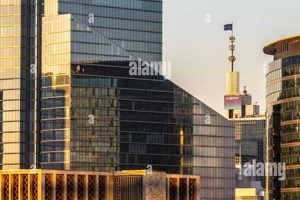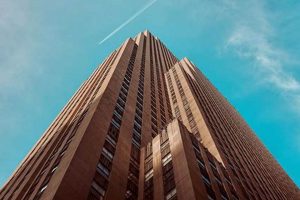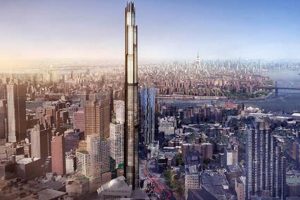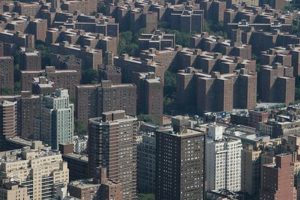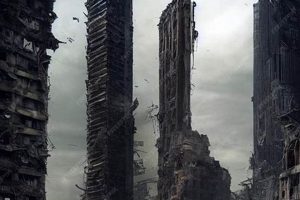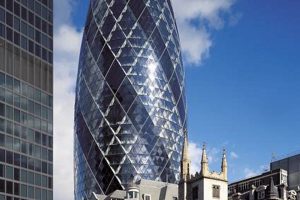Tokyo skyscrapers are among the tallest and most iconic structures in the world. They are a symbol of Japan’s economic and technological prowess, and they offer breathtaking views of the city skyline. Tokyo’s skyscrapers are used for a variety of purposes, including offices, residential units, and hotels. The most famous skyscraper in Tokyo is the Tokyo Skytree, which is the tallest tower in the world.
The construction of skyscrapers in Tokyo began in the early 20th century. The first skyscrapers were built in the Marunouchi district, which is now one of the most important business districts in Japan. In the 1960s and 1970s, there was a boom in skyscraper construction in Tokyo. This was due in part to the city’s rapid economic growth during that period. Today, Tokyo has over 400 skyscrapers, more than any other city in the world. Most skyscrapers in Tokyo are built to withstand earthquakes, which are common in Japan. They are also designed to be energy-efficient and environmentally friendly.
Tokyo’s skyscrapers are a major tourist attraction. Visitors from all over the world come to see these iconic structures. Many of the skyscrapers offer observation decks, which provide panoramic views of the city. Tokyo’s skyscrapers are also a popular setting for movies and television shows.
1. Height
Tokyo skyscrapers are renowned for their exceptional height, with many reaching extraordinary elevations. This vertical growth is not merely an architectural feat but also a reflection of Japan’s economic and technological prowess. The Tokyo Skytree, standing at an astounding 634 meters, exemplifies this pursuit of height and serves as a symbol of Tokyo’s ambition and modernity.
- Economic Significance
Towering skyscrapers, such as those in Tokyo, often house corporate headquarters, financial institutions, and multinational companies. Their presence attracts businesses and investments, contributing to the city’s economic vitality and global competitiveness. - Technological Advancements
The construction of supertall skyscrapers requires innovative engineering solutions and cutting-edge materials. Tokyo’s skyscrapers showcase Japan’s expertise in earthquake-resistant design, energy efficiency, and sustainable building practices. - Urban Planning
Skyscrapers allow for efficient land use in densely populated cities like Tokyo. They enable the concentration of businesses, services, and residential units within a compact area, optimizing space utilization and reducing urban sprawl. - Cultural Symbolism
Tokyo’s skyscrapers have become iconic landmarks, shaping the city’s skyline and contributing to its global recognition. They represent Japan’s technological prowess and economic strength, embodying the country’s drive for progress and innovation.
In conclusion, the height of Tokyo skyscrapers is not just a physical attribute but a testament to Japan’s economic, technological, and cultural achievements. They serve as symbols of the country’s ambition, innovation, and global standing, contributing to Tokyo’s reputation as a vibrant and modern metropolis.
2. Design
The architectural design of Tokyo skyscrapers is a captivating blend of tradition and innovation, reflecting Japan’s rich cultural heritage and its embrace of modernity. This diversity of styles contributes significantly to the unique character and visual appeal of Tokyo’s cityscape.
Historical Influences:
Traditional Japanese architectural elements, such as sloping roofs and wooden structures, can be found in some skyscrapers, paying homage to Japan’s architectural past. These elements are often incorporated in a contemporary manner, creating a harmonious fusion of old and new.
Modernist Movement:
The influence of the modernist movement is evident in many Tokyo skyscrapers, characterized by their clean lines, geometric forms, and emphasis on functionality. These buildings prioritize efficiency, simplicity, and the use of glass and steel, creating sleek and sophisticated structures.
Postmodernism and Beyond:
Postmodern and contemporary skyscrapers in Tokyo exhibit a wider range of styles, often incorporating bold forms, vibrant colors, and innovative materials. Architects experiment with unconventional shapes and designs, pushing the boundaries of architectural expression.
Practical Significance:
The diverse architectural styles of Tokyo skyscrapers cater to the varied needs and tastes of businesses and residents. Traditional elements can evoke a sense of cultural identity and continuity, while modern designs prioritize functionality and efficiency. Postmodern and contemporary styles offer opportunities for creative expression and architectural experimentation.
In conclusion, the design of Tokyo skyscrapers is a testament to Japan’s architectural prowess and its ability to blend tradition with innovation. The diverse range of styles not only enhances the aesthetic appeal of the city but also reflects the cultural and economic evolution of Tokyo. As the city continues to grow and evolve, its skyscrapers will undoubtedly continue to showcase the ingenuity and creativity of Japanese architects.
3. Function
Tokyo skyscrapers are not merely architectural marvels; they are highly functional structures that cater to a diverse range of needs. Their varied functions contribute significantly to the vibrancy and economic growth of Tokyo.
- Office Space
Tokyo skyscrapers house numerous corporate headquarters, financial institutions, and multinational companies. They provide modern and efficient workspaces, facilitating business activities and economic growth. - Residential Units
Many Tokyo skyscrapers offer luxury apartments and condominiums, catering to the city’s growing population and providing upscale living spaces with stunning views. - Commercial Spaces
Skyscrapers often incorporate retail stores, restaurants, and entertainment venues within their lower levels, creating vibrant urban hubs that attract residents and tourists alike. - Mixed-Use Developments
Mixed-use skyscrapers combine various functions, such as offices, residential units, retail spaces, and public amenities, creating self-contained urban environments that enhance convenience and foster community.
The multifunctional nature of Tokyo skyscrapers optimizes land use, promotes economic activity, and enhances the overall liveability of the city. They are not just symbols of economic power but also contribute
to the social and cultural fabric of Tokyo.
4. Technology
Tokyo skyscrapers are not just architectural marvels; they are also technological marvels. They are equipped with advanced technologies that make them energy-efficient, earthquake-resistant, and sustainable. These technologies are essential for a city like Tokyo, which is prone to earthquakes and has a large population.
One of the most important technologies used in Tokyo skyscrapers is seismic isolation. Seismic isolation systems are designed to protect buildings from earthquakes by absorbing and dissipating the energy of seismic waves. This technology has been used in many of Tokyo’s skyscrapers, including the Tokyo Skytree, the tallest building in Japan. Seismic isolation systems have proven to be very effective in protecting buildings from earthquakes. In the 2011 Tohoku earthquake, for example, buildings in Tokyo that were equipped with seismic isolation systems sustained minimal damage.
Another important technology used in Tokyo skyscrapers is energy efficiency. Energy-efficient technologies can help to reduce the amount of energy used by a building, which can lead to significant cost savings. Some of the energy-efficient technologies used in Tokyo skyscrapers include LED lighting, solar panels, and rainwater harvesting systems.
Sustainability is also an important consideration in the design of Tokyo skyscrapers. Sustainable technologies can help to reduce the environmental impact of a building. Some of the sustainable technologies used in Tokyo skyscrapers include green roofs, which can help to reduce heat island effects, and rainwater harvesting systems, which can help to reduce water usage.
The advanced technologies used in Tokyo skyscrapers make them more energy-efficient, earthquake-resistant, and sustainable. These technologies are essential for a city like Tokyo, which is prone to earthquakes and has a large population. They help to make Tokyo a more livable and sustainable city.
5. Views
Observation decks in Tokyo skyscrapers provide breathtaking panoramic vistas of the city and surrounding areas, making them a popular destination for tourists and locals alike. These decks offer a unique perspective on the city’s sprawling cityscape and iconic landmarks, allowing visitors to experience Tokyo from a new and elevated vantage point.
- Unparalleled Views
Observation decks offer unobstructed views of Tokyo’s vast urban landscape, stretching from the city center to the distant mountains. Visitors can take in the city’s iconic landmarks, such as Tokyo Tower, the Tokyo Skytree, and the Imperial Palace, from a unique aerial perspective. - Day and Night Experiences
Observation decks are open during both daytime and nighttime hours, offering visitors different experiences of the city. Daytime visits provide clear views of the city’s architecture and layout, while nighttime visits showcase the city’s vibrant lights and illuminated landmarks. - Cultural Immersion
Observation decks often incorporate cultural elements into their design, providing visitors with an immersive experience of Japanese culture. Some decks feature traditional Japanese architecture, while others offer interactive exhibits that showcase the city’s history and heritage. - Landmark Destinations
Observation decks have become landmark destinations in their own right, attracting visitors from around the world. They are often located in iconic skyscrapers that are symbols of Tokyo’s economic and technological prowess, such as the Tokyo Skytree.
In conclusion, the observation decks in Tokyo skyscrapers offer breathtaking panoramic vistas that provide visitors with a unique and unforgettable experience of the city. These decks not only offer unparalleled views but also serve as cultural landmarks that showcase Tokyo’s vibrant energy and rich heritage.
6. Culture
Tokyo’s skyscrapers are not just architectural marvels; they are also cultural icons that are deeply intertwined with the city’s identity. Skyscrapers have featured prominently in Japanese art, literature, and popular media, reflecting their importance as symbols of Tokyo’s economic power and cultural significance.
In art, skyscrapers have been depicted in various forms, from traditional ukiyo-e prints to contemporary paintings and sculptures. These depictions often capture the awe-inspiring scale and grandeur of Tokyo’s skyscrapers, as well as their role in shaping the city’s skyline. For example, the artist Katsushika Hokusai famously depicted Mount Fuji alongside a cluster of skyscrapers in his iconic print “The Great Wave off Kanagawa.” This juxtaposition highlights the harmonious coexistence of tradition and modernity in Tokyo, with skyscrapers emerging as symbols of progress and ambition.
In literature, skyscrapers have served as settings for numerous novels, short stories, and poems. These works often explore the social and cultural implications of Tokyo’s rapid urbanization and the impact of skyscrapers on the lives of its inhabitants. For example, the novel “The Tower of Tokyo” by Natsuo Kirino delves into the lives of the residents of a luxury high-rise apartment building, exposing the hidden tensions and desires that exist within the seemingly perfect facade.
In popular media, skyscrapers have become ubiquitous backdrops for movies, TV shows, and anime. These depictions often portray skyscrapers as symbols of power, wealth, and ambition. For example, the movie “Godzilla” features the iconic Tokyo Tower as a symbol of the city’s resilience and determination to rebuild after destruction. These depictions have further cemented the image of Tokyo skyscrapers in the global consciousness, making them recognizable symbols of Japan’s economic and cultural prowess.
In conclusion, the deep connection between Tokyo’s skyscrapers and its culture highlights their significance not just as architectural structures but also as cultural symbols that embody the city’s history, identity, and aspirations. Understanding this connection provides a deeper appreciation for the role that skyscrapers play in shaping the fabric of Tokyo and its place in the global imagination.
7. Tourism
The connection between Tokyo’s skyscrapers and tourism is undeniable. These towering structures, with their unique architectural designs and breathtaking views, have become major tourist attractions, drawing visitors from around the world. This influx of tourism has a significant impact on Tokyo’s economy and contributes to the city’s global recognition.
One key reason for the popularity of Tokyo’s skyscrapers as tourist attractions is their architectural significance. Many of these buildings are considered masterpieces of modern architecture, showcasing innovative designs and cutting-edge construction techniques. For example, the Tokyo Skytree, the tallest structure in Japan, is renowned for its futuristic appearance and its observation deck, which offers panoramic views
of the city. These architectural marvels attract architecture enthusiasts and tourists alike, who come to admire their beauty and learn about their design.
Another reason for the appeal of Tokyo’s skyscrapers is the breathtaking views they offer. Many of these buildings have observation decks or rooftop terraces that allow visitors to experience the city’s skyline from above. These vantage points provide stunning views of Tokyo’s urban landscape, including its iconic landmarks, such as the Tokyo Tower and the Imperial Palace. The panoramic vistas from these skyscrapers have made them popular destinations for tourists who want to capture memorable photos and create lasting memories of their visit to Tokyo.
The tourism industry in Tokyo benefits greatly from the presence of these skyscraper attractions. Visitors to these buildings often spend money on admission fees, souvenirs, and dining at restaurants within the skyscrapers. This revenue contributes to the local economy and supports businesses in the surrounding areas. Additionally, the presence of skyscrapers as tourist attractions helps to promote Tokyo as a vibrant and modern city, attracting even more visitors in the future.
In conclusion, the connection between Tokyo’s skyscrapers and tourism is mutually beneficial. The architectural significance and breathtaking views offered by these skyscrapers draw visitors from around the world, contributing to Tokyo’s economy and global recognition. Understanding this connection is essential for appreciating the multifaceted role that skyscrapers play in the city’s development and its appeal as a major tourist destination.
8. Economic Impact
Tokyo’s skyscrapers are not just architectural marvels; they are also major contributors to the city’s economy. The construction and maintenance of these towering structures create numerous employment opportunities in various sectors, including architecture, engineering, construction, and property management. These jobs contribute to the local economy and support the livelihoods of many individuals and families.
Furthermore, skyscrapers house a significant number of businesses, both large and small. These businesses range from multinational corporations to small startups, and they contribute to Tokyo’s economic growth and vitality. The presence of skyscrapers in Tokyo attracts businesses from around the world, creating a vibrant and diverse business environment. The concentration of businesses in skyscrapers fosters collaboration, innovation, and economic growth.
The economic impact of Tokyo’s skyscrapers extends beyond the direct employment and business opportunities they provide. These buildings also contribute to the city’s overall attractiveness as a business destination. The presence of iconic skyscrapers makes Tokyo a desirable location for businesses to establish their headquarters or regional offices, further boosting the city’s economy.
In conclusion, the economic impact of Tokyo’s skyscrapers is significant. They provide employment opportunities, house businesses, and contribute to the city’s attractiveness as a business destination. Understanding the economic impact of skyscrapers is essential for appreciating their importance not just as architectural structures but also as drivers of Tokyo’s economic growth and prosperity.
Frequently Asked Questions about Tokyo Skyscrapers
Tokyo’s skyscrapers are iconic structures that symbolize the city’s economic prosperity and architectural innovation. Here are some frequently asked questions about these remarkable buildings:
Question 1: What is the tallest skyscraper in Tokyo?
Answer: The tallest skyscraper in Tokyo is the Tokyo Skytree, which stands at an impressive height of 634 meters (2,080 feet). It is also the tallest tower in the world.Question 2: How many skyscrapers are there in Tokyo?
Answer: Tokyo has over 400 skyscrapers, making it the city with the most skyscrapers in the world.Question 3: What is the oldest skyscraper in Tokyo?
Answer: The oldest skyscraper in Tokyo is the Marunouchi Building, which was completed in 1923. It is a 12-story building and is considered a historical landmark.Question 4: What is the most famous skyscraper in Tokyo?
Answer: The most famous skyscraper in Tokyo is the Tokyo Skytree. It is not only the tallest building in Tokyo but also a popular tourist destination, offering panoramic views of the city from its observation deck.Question 5: What are some of the most iconic skyscrapers in Tokyo?
Answer: Some of the most iconic skyscrapers in Tokyo include the Tokyo Skytree, the Tokyo Tower, the Roppongi Hills Mori Tower, the Tokyo Metropolitan Government Building, and the Sunshine 60 Building.Question 6: What are the benefits of having skyscrapers in Tokyo?
Answer: Skyscrapers in Tokyo provide numerous benefits, including increased office space, improved urban planning, enhanced energy efficiency, and reduced traffic congestion. They also attract businesses and investments, contributing to the city’s economic growth and global competitiveness.
These frequently asked questions provide a brief overview of Tokyo’s skyscrapers, their significance, and their impact on the city. Understanding these aspects enhances the appreciation of these architectural marvels and their role in shaping Tokyo’s skyline and global recognition.
Proceed to the next section for more detailed information about Tokyo skyscrapers.
Tips for Visiting Tokyo Skyscrapers
Tokyo’s skyscrapers are architectural marvels that offer stunning views and unique experiences. Here are some tips to make the most of your visit:
Tip 1: Plan Your Visit
Before visiting, check the opening hours and admission fees for the observation decks. Consider purchasing tickets in advance, especially during peak tourist seasons, to avoid long lines.
Tip 2: Choose the Right Time
For the best views, visit during weekdays or early on weekends to avoid crowds. Sunset and evening visits offer spectacular cityscapes, while daytime visits provide clear panoramas.
Tip 3: Bring Your Camera
Observation decks offer breathtaking photo opportunities. Bring a camera with a wide-angle lens to capture the expansive city views. Tripods are usually not permitted, so use the available railings or windowsills for support.
Tip 4: Allow Ample Time
Set aside ample time for your visit. Besides enjoying the views, most skyscrapers have gift shops and cafes where you can relax and take in the ambiance.
Tip 5: Respect the Rules
Follow the rules and regulations of the observation decks. This may include refraining from running, smoking, or using flash photography. Be mindful of other visitors and maintain a respectful distance.
Tip 6: Consider Guided Tours
Some skyscrapers offer guided tours that provide insights into the building’s architecture, history, and engineering. These tours can enhance your visit and offer unique perspectives.
Tip 7: Explore the Surroundings
Many skyscrapers are located in vibrant urban areas. After your visit, take some time to explore the surrounding streets, shops, and restaurants, to experience the bustling atmosphere of Tokyo.
Tip 8: Enjoy the Night Views
Tokyo’s skyscrapers transform into illuminated beacons at night. Consider visiting an observation deck during evening hours to witness the city’s dazzling skyline.
By following these tips, you can plan a memorable and enriching visit to Tokyo’s skyscrapers, capturing the essence of the city’s architectural prowess and vibrant urban landscape.
Conclusion
Tokyo’s skyscrapers stand as testaments to the city’s economic might, architectural ingenuity, and cultural heritage. Their towering heights, diverse designs, and advanced technologies showcase Japan’s unwavering pursuit of progress and innovation. These iconic structures not only provide functional spaces for businesses and residents but also contribute significantly to the city’s tourism industry and global recognition.
As Tokyo continues to evolve, its skyscrapers will undoubtedly continue to play a vital role in shaping the city’s skyline and identity. They serve as reminders of Japan’s resilience, ambition, and unwavering commitment to the future. Whether viewed from afar or experienced from their lofty observation decks, Tokyo’s skyscrapers invite us to marvel at the achievements of human ingenuity and to envision the boundless possibilities that lie ahead.


